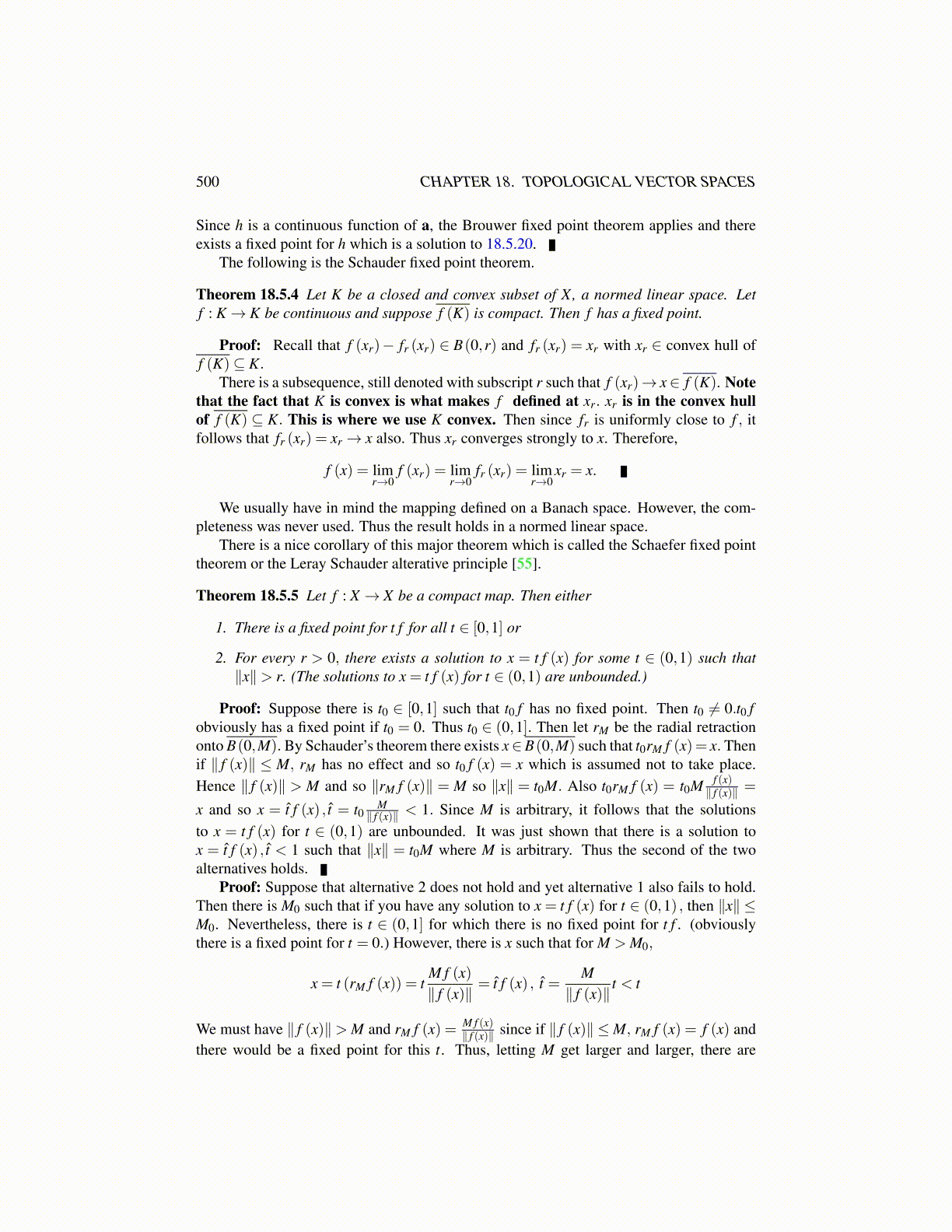
500 CHAPTER 18. TOPOLOGICAL VECTOR SPACES
Since h is a continuous function of a, the Brouwer fixed point theorem applies and thereexists a fixed point for h which is a solution to 18.5.20.
The following is the Schauder fixed point theorem.
Theorem 18.5.4 Let K be a closed and convex subset of X, a normed linear space. Letf : K→ K be continuous and suppose f (K) is compact. Then f has a fixed point.
Proof: Recall that f (xr)− fr (xr) ∈ B(0,r) and fr (xr) = xr with xr ∈ convex hull off (K)⊆ K.
There is a subsequence, still denoted with subscript r such that f (xr)→ x∈ f (K). Notethat the fact that K is convex is what makes f defined at xr. xr is in the convex hullof f (K) ⊆ K. This is where we use K convex. Then since fr is uniformly close to f , itfollows that fr (xr) = xr→ x also. Thus xr converges strongly to x. Therefore,
f (x) = limr→0
f (xr) = limr→0
fr (xr) = limr→0
xr = x.
We usually have in mind the mapping defined on a Banach space. However, the com-pleteness was never used. Thus the result holds in a normed linear space.
There is a nice corollary of this major theorem which is called the Schaefer fixed pointtheorem or the Leray Schauder alterative principle [55].
Theorem 18.5.5 Let f : X → X be a compact map. Then either
1. There is a fixed point for t f for all t ∈ [0,1] or
2. For every r > 0, there exists a solution to x = t f (x) for some t ∈ (0,1) such that∥x∥> r. (The solutions to x = t f (x) for t ∈ (0,1) are unbounded.)
Proof: Suppose there is t0 ∈ [0,1] such that t0 f has no fixed point. Then t0 ̸= 0.t0 fobviously has a fixed point if t0 = 0. Thus t0 ∈ (0,1]. Then let rM be the radial retractiononto B(0,M). By Schauder’s theorem there exists x∈B(0,M) such that t0rM f (x)= x. Thenif ∥ f (x)∥ ≤ M, rM has no effect and so t0 f (x) = x which is assumed not to take place.Hence ∥ f (x)∥ > M and so ∥rM f (x)∥ = M so ∥x∥ = t0M. Also t0rM f (x) = t0M f (x)
∥ f (x)∥ =
x and so x = t̂ f (x) , t̂ = t0 M∥ f (x)∥ < 1. Since M is arbitrary, it follows that the solutions
to x = t f (x) for t ∈ (0,1) are unbounded. It was just shown that there is a solution tox = t̂ f (x) , t̂ < 1 such that ∥x∥ = t0M where M is arbitrary. Thus the second of the twoalternatives holds.
Proof: Suppose that alternative 2 does not hold and yet alternative 1 also fails to hold.Then there is M0 such that if you have any solution to x = t f (x) for t ∈ (0,1) , then ∥x∥ ≤M0. Nevertheless, there is t ∈ (0,1] for which there is no fixed point for t f . (obviouslythere is a fixed point for t = 0.) However, there is x such that for M > M0,
x = t (rM f (x)) = tM f (x)∥ f (x)∥
= t̂ f (x) , t̂ =M
∥ f (x)∥t < t
We must have ∥ f (x)∥> M and rM f (x) = M f (x)∥ f (x)∥ since if ∥ f (x)∥ ≤M, rM f (x) = f (x) and
there would be a fixed point for this t. Thus, letting M get larger and larger, there are